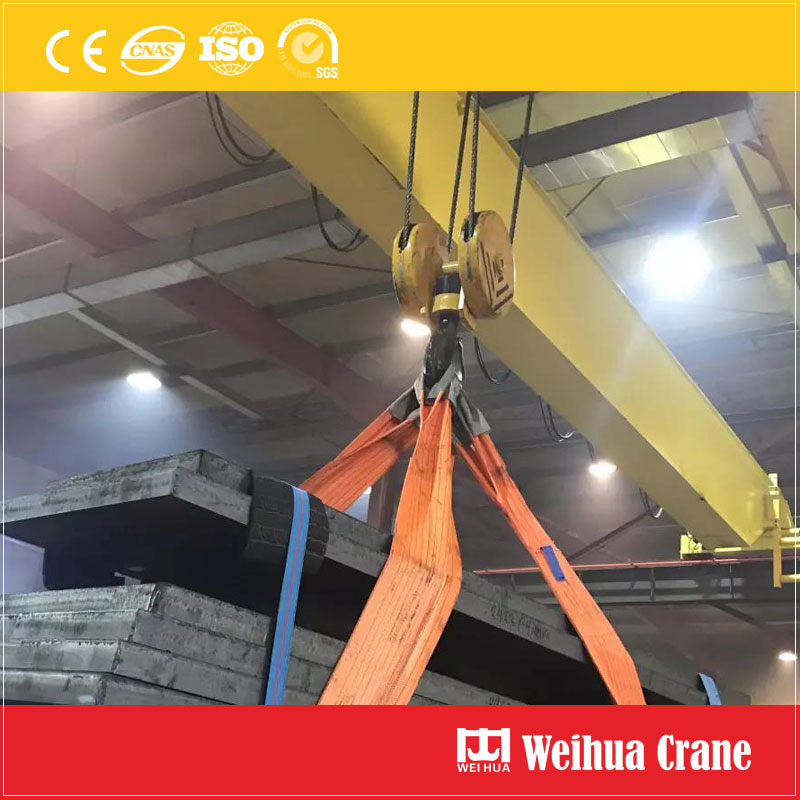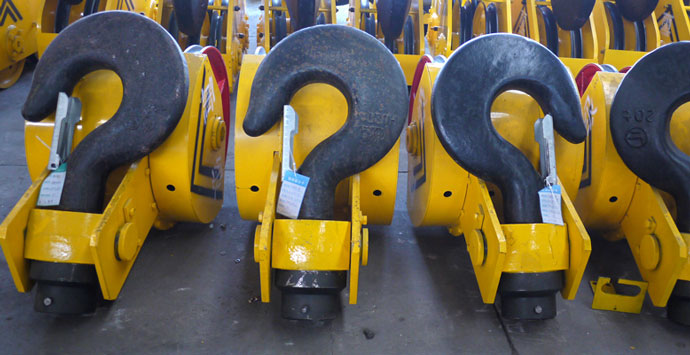في عالم التعدين الشاق, حيث يتم رفع الأحمال الهائلة, تحول, ونقلها باستمرار, ال خطاف الرافعة يبدو عنصرًا بسيطًا ولكنه بالغ الأهمية بشكل أساسي. إنها شريان الحياة الذي يربط بين قوة الرافعة الهائلة والحمولة القيمة – سواء كانت خامًا, الآلات, أو العناصر الهيكلية. إن إهمال صيانة خطافات رافعة التعدين ليس خيارًا; فهو يدعو إلى الفشل الكارثي, يعرض حياة الناس للخطر, يوقف العمليات, ويتكبد خسائر مالية فادحة. صارمة, يعد برنامج الصيانة الاستباقية أمرًا بالغ الأهمية للسلامة واستمرارية التشغيل.

البيئات المتطرفة: تتعرض للغبار جلخ, المواد الكيميائية المسببة للتآكل (مثل الطين أو الجريان السطحي الحمضي), رُطُوبَة, وتقلبات واسعة في درجات الحرارة, تتدهور الخطافات بشكل أسرع مما هي عليه في معظم الصناعات.
دورات تحميل مكثفة: تتضمن عمليات التعدين عمليات رفع متكررة, في كثير من الأحيان بالقرب من أو عند حمل العمل الآمن للرافعة (SWL), إخضاع الخطافات لدورات التعب عالية الضغط.
تحميل التأثير والصدمة: التعامل الخام, الاصطدامات العرضية مع الوجوه الصخرية أو المعدات, وظروف الأرض غير المستوية تخلق قوى تأثير مفاجئة.
التآكل الثقيل والتمزق: تعمل المواد الكاشطة التي تتصل بالخطاف باستمرار على تسريع التآكل على الأسطح الحاملة الحرجة.
1. صارم, عمليات التفتيش المجدولة:
فحوصات ما قبل الاستخدام: يجب على المشغلين فحص الخطاف بصريًا (جسم, مزلاج إذا كانت مجهزة, قطب, ونقطة التعلق) لضرر واضح, تشوه, تشققات, أو التآكل المفرط قبل كل وردية. تحقق من وظيفة المزلاج بدقة.
عمليات التفتيش المتكررة: تتم من قبل موظفين مختصين (على سبيل المثال, الحفارون, المشرفين) أسبوعية أو شهرية. يتضمن تنظيفًا شاملاً وفحصًا بصريًا دقيقًا باستخدام أدوات مثل العدسات المكبرة. التركيز على المناطق ذات الضغط العالي: الحلق (سرج), عرقوب, نصيحة, وآلية المزلاج.
التفتيش الدوري: يتم تنفيذها بشكل ربع سنوي أو نصف سنوي من قبل مفتشين معتمدين. هذا ينطوي على:
القياس التفصيلي: استخدام الفرجار والمقاييس لقياس فتحة الحلق (مقارنة بالمواصفات الأصلية + حدود التآكل المسموح بها - عادةً 10-15% أقصى زيادة).
فحص الالتواء/التشويه: التأكد من عدم التواء الخطاف أو انحناءه خارج المستوى.
اختبار غير التدمير (NDT): ضروري! تقنيات مثل فحص الجسيمات المغناطيسية (MPI) أو اختبار الموجات فوق الصوتية (يوتا) تستخدم للكشف عن الشقوق تحت السطح, عيوب, أو التعب الذي لا يرى بالعين المجردة. هذا غير قابل للتفاوض بالنسبة للخطافات في الخدمة الشديدة.
حفظ السجلات: توثيق دقيق لكل عملية تفتيش, النتائج, القياسات, نتائج NDT, وأي صيانة يتم إجراؤها تعتبر أمرًا بالغ الأهمية للتتبع والامتثال (على سبيل المثال, مع أسم B30.10, لوائح OSHA/MSHA).

2. الصيانة والإصلاح الاستباقي:
تنظيف: إزالة جميع الأوساخ, وسخ, والمواد الكاشطة بانتظام لتمكين الفحص المناسب ومنع التآكل/التآكل المتسارع. استخدم المذيبات أو طرق التنظيف المناسبة.
تشحيم: تأكد من أن الآليات الدوارة تعمل بسلاسة باستخدام مادة التشحيم الصحيحة, تطبق على فترات موصى بها. منع الاستيلاء.
التحكم في التآكل: تطبيق الطلاءات الواقية المناسبة أو مثبطات التآكل, خاصة في البيئات شديدة التآكل. معالجة الصدأ السطحي على الفور.
حدود التآكل: فهم حدود التآكل المحددة من قبل الشركة المصنعة والالتزام بها بشكل صارم, خاصة بالنسبة لفتح الحلق وارتداء الأطراف. لا تحاول اللحام أبدًا, ينحني للخلف, أو إصلاح متصدع بطريقة أخرى, مشوه, أو هوك البالية بشدة. الاستبدال هو الخيار الآمن الوحيد.
صيانة المزلاج: تأكد من المزالج (إذا استخدمت) التحرك بحرية, الانخراط بشكل إيجابي, وغير تالفة أو البالية. المزالج الخاطئة هي السبب الرئيسي لانزلاق التحميل.
3. بروتوكول استبدال الخطاف:
معايير التخلص الإلزامية: استبدل الخطافات على الفور إذا كشف الفحص:
أي صدع (السطحية أو تحت السطحية).
الإفراط في فتح الحلق (خارج حدود الشركة المصنعة/التنظيمية).
أي التواء, الانحناء, أو العنق (انخفاض في قطر عرقوب).
ارتداء تتجاوز 10-15% من البعد الأصلي عند السرج أو الطرف.
تآكل كبير يؤثر على السلامة الهيكلية.
تشويه نقطة الخطاف.
تالف, مفتقد, أو علامة تعريف SWL غير مقروءة.
التتبع: استبدل فقط بخطافات تفي بمواصفات الشركة المصنعة الأصلية, معتمدة للمعايير ذات الصلة (على سبيل المثال, ASME B30.10, من, ISO), وتم وضع علامة واضحة عليها مع SWL الخاصة بهم. الاحتفاظ بسجلات البدائل.
4. التدريب والثقافة:
وعي المشغل: تدريب مشغلي الرافعات وعمال الحفر على التعرف على العلامات الأساسية لتلف الخطاف, فهم أهمية فحوصات ما قبل الاستخدام, والإبلاغ عن أي مخاوف على الفور. التأكيد على ممارسات التزوير الآمنة لتقليل تحميل الصدمات.
كفاءة المفتش: تأكد من تدريب الموظفين الذين يقومون بعمليات التفتيش التفصيلية واختبارات الاختبار غير التدميرية بشكل صحيح, معتمد, وذوي الخبرة.
السلامة أولا: تعزيز ثقافة حيث تتجاوز السلامة ضغط الإنتاج. تمكين أي شخص من التوقف عن العمل إذا كان هناك شك في أن الخطاف غير آمن.

إن صيانة خطاف رافعة التعدين هي أكثر بكثير من مجرد عمل روتيني; إنها ضرورة أساسية للسلامة وحجر زاوية للموثوقية التشغيلية. تنفيذ برنامج منهجي يشمل عمليات التفتيش المتكررة (بما في ذلك الاختبارات غير التدميرية الإلزامية), الصيانة الاستباقية, الالتزام الصارم بمعايير التخلص, إجراءات الاستبدال المناسبة, والتدريب الشامل ضروري. من خلال التعامل مع الخطاف المتواضع بالاحترام الذي يتطلبه دوره الحاسم, تحمي عمليات التعدين أصولها الأكثر قيمة: شعوبهم واستمرارية مشاريعهم. لا تقلل أبدًا من أهمية هذا الرابط الحيوي في سلسلة الرفع.
نحن نقدر ملاحظاتك! يرجى إكمال النموذج أدناه حتى نتمكن من تخصيص خدماتنا حسب احتياجاتك المحددة.

أحدث التعليقات